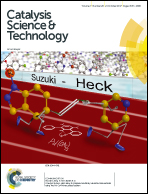Designing bifunctional alkene isomerization catalysts using predictive modelling†
Abstract
Controlling the isomerization of alkenes is important for the manufacturing of fuel additives, fine-chemicals and pharmaceuticals. But even if isomerization seems to be a simple unimolecular process, the factors that govern catalyst performance are far from clear. Here we present a set of models that describe selectivity and activity, enabling the rational design and synthesis of alkene isomerization catalysts. The models are based on simple molecular descriptors, with a low computational cost, and are tested and validated on a set of eleven known Ru-imidazol-phosphine complexes and two new ones. Despite their simplicity, these models show good predictive power, with R2 values of 0.60–0.85. Using a combination of principal components analysis (PCA) and partial least squares (PLS) regression, we construct a “catalyst map”, that captures trends in reactivity and selectivity as a function of electrostatic charge on the N* atom, EHOMO, polar surface area and the optimal mass substituents on P/distance Ru–P ratio. In addition to indicating “good regions” in the catalyst space, these models also give insight into mechanistic steps. For example, we find that the electrostatic charge on N*, EHOMO and polar surface area are crucial in the rate-limiting step, whereas the optimal mass of substituents on P/distance Ru–P is correlated with the product selectivity.



 Please wait while we load your content...
Please wait while we load your content...